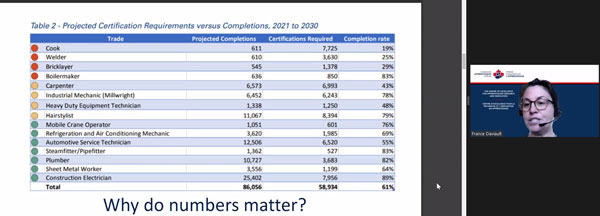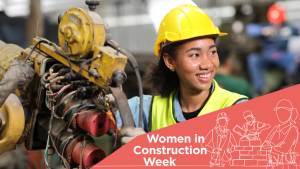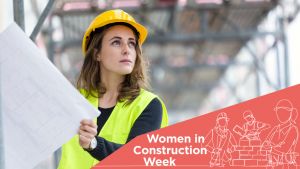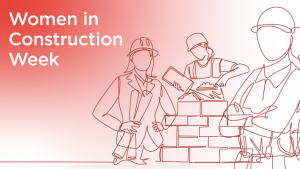It’s common knowledge that women entering the construction trades face barriers and what those barriers are but now it’s time to do something about it.
“Here is my question…why is this still a thing?” asked France Daviault, executive director of the Canadian Apprenticeship Forum, at a Women in Construction conference hosted by the Residential Construction Council of Ontario recently.
“We’re still having conferences and the conversation is still around barriers – barriers to entry and barriers to (apprenticeship) completion. There’s over 30 years of documented research done on why women are underrepresented in the skilled trades and what the barriers are. We have been talking about this for a really long time.
“We have to ask ourselves ‘so now what?’ ”
While there are efforts across the country to promote skilled trades for women, barriers still exist and those include work scheduling as women are often primary caregivers in the family. The reputation of the industry and job postings that don’t make it clear that women and underrepresented groups are welcome are still an issue.
There are also barriers to staying in the skilled trades as women leave the trades at a higher rate than men.

“The top reason is that there is still harassment and bullying on worksites,” said Daviault. “There are a lot of well-meaning people working in HR or working in management for the employers and there are very good, solid HR policies on paper. The thing that we are hearing unfortunately is that those nice policies and those good intentions don’t necessarily translate to what is actually happening on the worksites.”
They are also still hearing women on worksites would like to have available washrooms, proper fitting PPE and many of them leave because there is discrimination when it comes to advancement or pay.
So what can be done to change the numbers? While there are arguments for and against implementing quotas on infrastructure projects, they are meant to bring things up to an even playing field, Daviault noted.
“I wasn’t sure if I was going to actually put this in the presentation because it’s kind of a scary word. I know there are pros and cons for this ‘quota’ word,” she pointed out. “Historically quotas have been shown to work, they have been shown to move the numbers up for women who either want to be more represented on boards, in different sectors and now we’re looking at skilled trades. Why would they be any different than what has been proven to work in other sectors?”
Having a zero-tolerance policy for harassment on all worksites and enforcing it is also key as is having mentors for women.
Speakers open up about real-life barriers
A panel discussion immediately followed Daviault that built on some of her points.
It was moderated by Jennifer Green of Skills Ontario and featured tile setter Alexandra Wells, assistant production manager Maryam Amin and plumber and gasfitter Bailey Wood.
Wood is currently on mat leave and she had some advice for tradeswomen who are thinking of starting a family.
“It’s doable. There are programs in place at most workplaces to put you on lighter duties,” she said. “I did work the majority of my pregnancy. You just need to reach out and talk to the office and make sure they are putting you in a good, safe position.”
“I was the first pregnant tradesperson at an international company and my manager walked into HR and said, ‘I have a pregnant millwright what do I do?’ ” Green told the audience. “Make sure you work with your company to come up with a comprehensive strategy. I had to make sure I stopped climbing out of large industrial machines at seven, eight and nine months pregnant.”
In terms of experience, one of the things all the female panellists cited was feeling the need to prove yourself on a worksite.
“My male co-workers have the same credentials, they have the same background but for some reason there is something that makes me feel like I have to try harder,” said Wood. “The solution to that is just making sure that you are educated and having that belief in yourself that you can do the job.”
Wells said she is lucky to work for a company that has a female CEO. She now runs a crew of 10 male installers and although she faces challenges, they all support her.
“I’ve gone on jobsites and I’ll have a male co-worker with me and the first thing they do is look at them and go ‘oh, you’re who I need to talk to’ and they say ‘no, she’s the boss.’ I have been fortunate enough to have those co-workers who have had my back, male and female.”
The way males interact with each other on a worksite can make some women uncomfortable, said Wells. Boundaries need to be put in place for all workers.
“It’s very difficult because there are a lot of times that I have to come across as a very cold-hearted person because if I don’t initiate that from the very beginning, they think that I can just be walked over,” she explained. “It’s sad to say because a lot of my co-workers, you see them more than you see your family so you tend to grow those relationships. However, what I worry about always is somebody overstepping that boundary.
“I don’t like when people get into my personal space and to have that discussion with people is quite difficult.”
Follow the author on Twitter .











I see very few women on sites. They’re usually tough. I’m sure they deal with some challenges like bathroom issues for example. Some are given special treatment and some don’t need it. But hey could be worse because the nooses that get hung racist graffiti in the bathrooms aren’t directed towards them.